2014 MERCEDES-BENZ C-CLASS ESTATE display
[x] Cancel search: displayPage 161 of 489
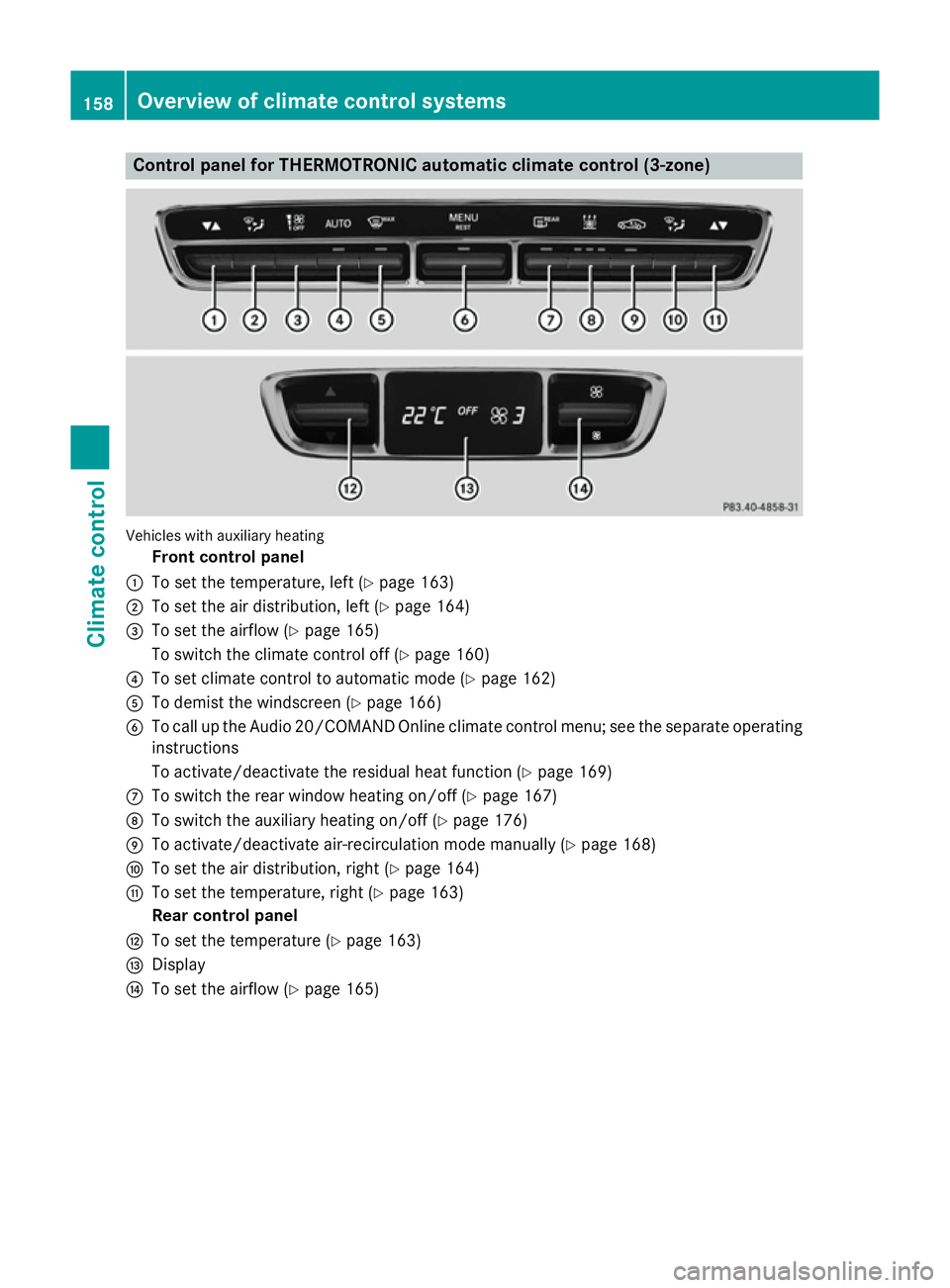
Control panel for THERMOTRONIC automatic climate control (3-zone)
Vehicles with auxiliary heating
Front control panel
: To set the temperature, left (Y page 163)
; To set the air distribution, left (Y page 164)
= To set the airflow (Y page 165)
To switch the climate control off (Y page 160)
? To set climate control to automatic mode (Y page 162)
A To demist the windscreen (Y page 166)
B To call up the Audio 20/COMAND Online climate control menu; see the separate operating
instructions
To activate/deactivate the residual heat function (Y page 169)
C To switch the rear window heating on/off (Y page 167)
D To switch the auxiliary heating on/off (Y page 176)
E To activate/deactivate air-recirculation mode manually (Y page 168)
F To set the air distribution, right (Y page 164)
G To set the temperature, right (Y page 163)
Rear control panel
H To set the temperature (Y page 163)
I Display
J To set the airflow (Y page 165)158
Overview of climate control systemsClimate control
Page 162 of 489
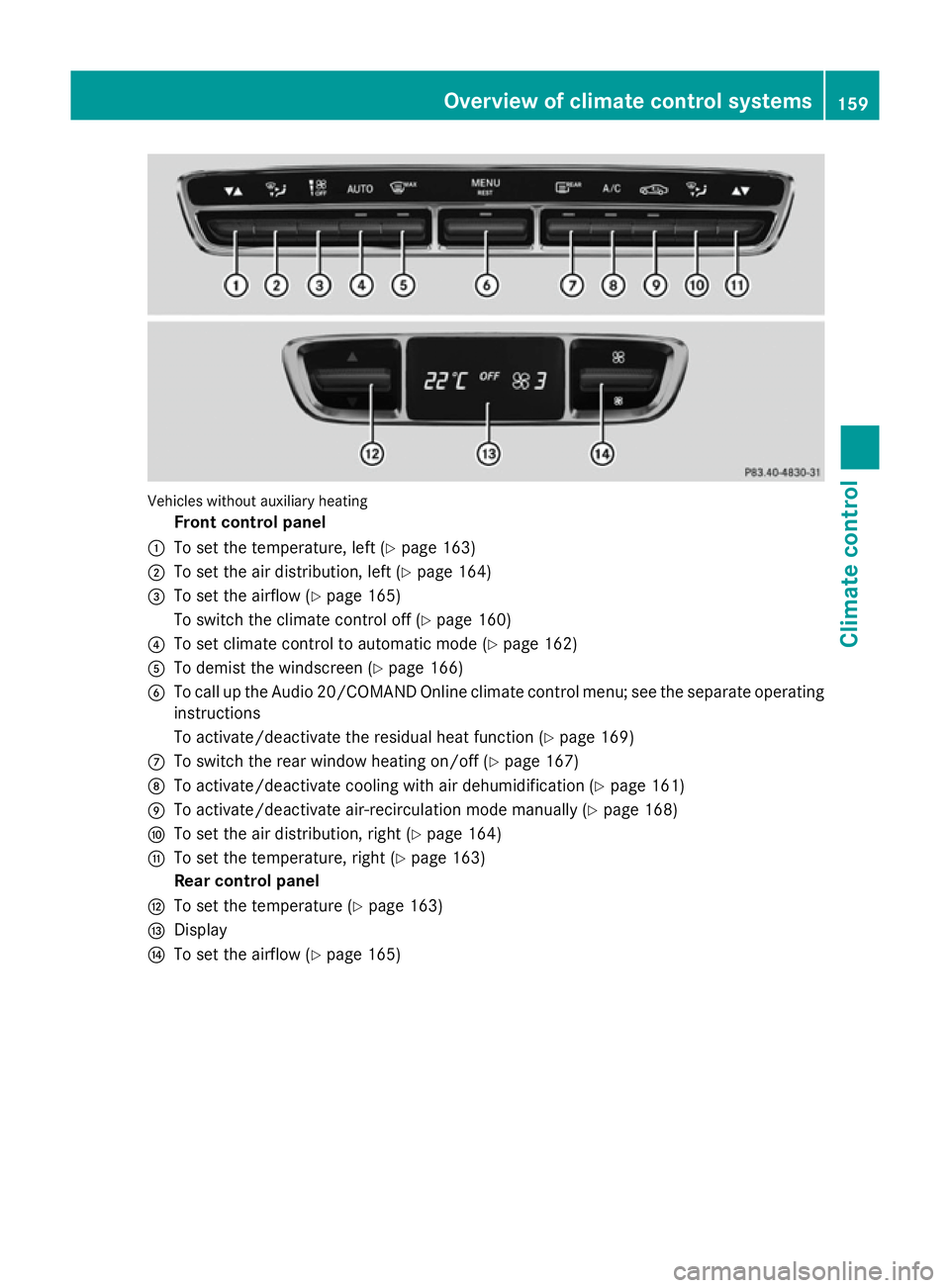
Vehicles without auxiliary heating
Front control panel
: To set the temperature, left (Y page 163)
; To set the air distribution, left (Y page 164)
= To set the airflow (Y page 165)
To switch the climate control off (Y page 160)
? To set climate control to automatic mode (Y page 162)
A To demist the windscreen (Y page 166)
B To call up the Audio 20/COMAND Online climate control menu; see the separate operating
instructions
To activate/deactivate the residual heat function (Y page 169)
C To switch the rear window heating on/off (Y page 167)
D To activate/deactivate cooling with air dehumidification (Y page 161)
E To activate/deactivate air-recirculation mode manually (Y page 168)
F To set the air distribution, right (Y page 164)
G To set the temperature, right (Y page 163)
Rear control panel
H To set the temperature (Y page 163)
I Display
J To set the airflow (Y page 165) Overview of climate control systems
159Climate control
Page 167 of 489
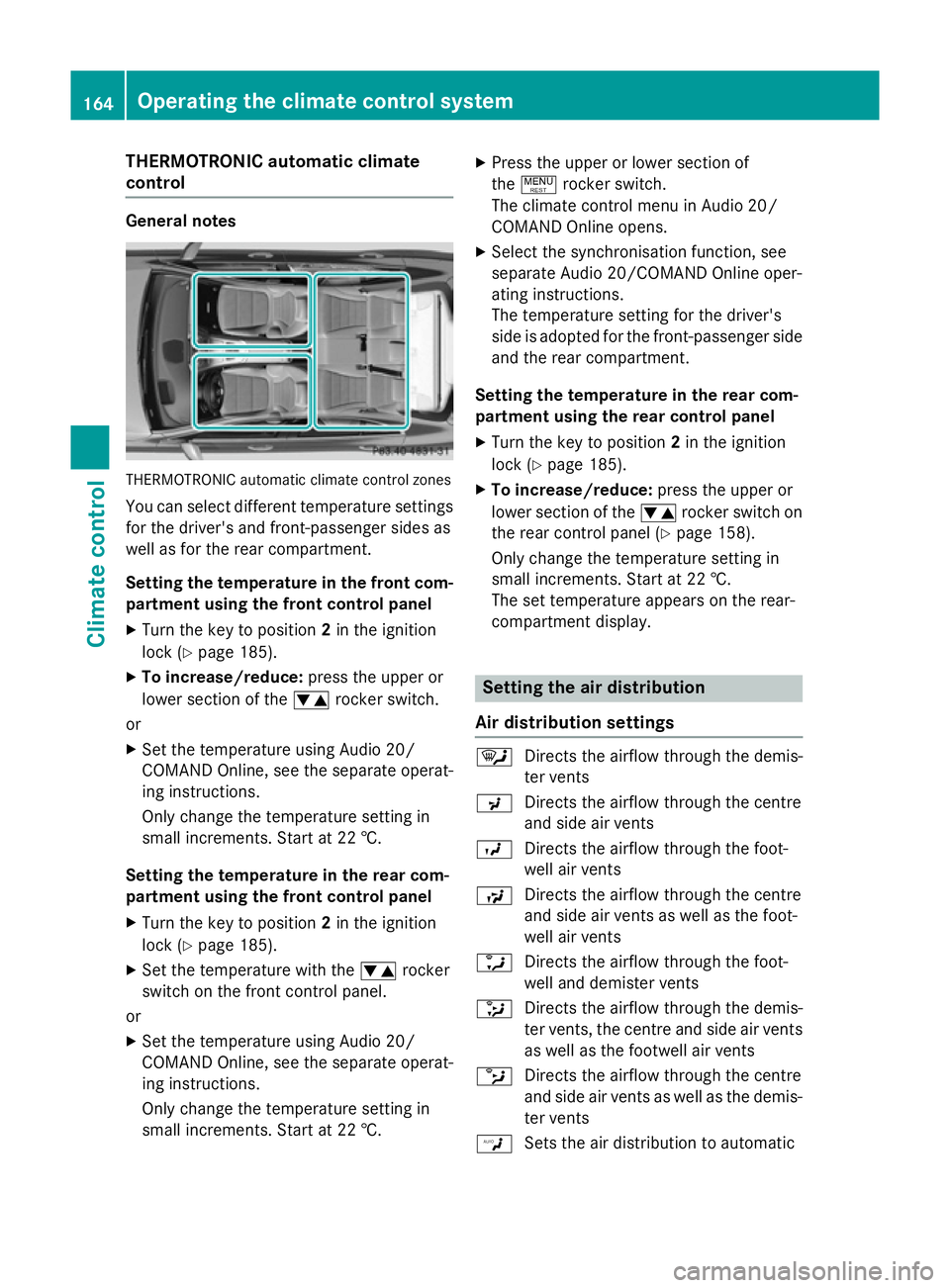
THERMOTRONIC automatic climate
control General notes
THERMOTRONIC automatic climate control zones
You can select different temperature settings for the driver's and front-passenger sides as
well as for the rear compartment.
Setting the temperature in the front com-
partment using the front control panel
X Turn the key to position 2in the ignition
lock (Y page 185).
X To increase/reduce: press the upper or
lower section of the wrocker switch.
or X Set the temperature using Audio 20/
COMAND Online, see the separate operat-
ing instructions.
Only change the temperature setting in
small increments. Start at 22 †.
Setting the temperature in the rear com-
partment using the front control panel X Turn the key to position 2in the ignition
lock (Y page 185).
X Set the temperature with the wrocker
switch on the front control panel.
or
X Set the temperature using Audio 20/
COMAND Online, see the separate operat-
ing instructions.
Only change the temperature setting in
small increments. Start at 22 †. X
Press the upper or lower section of
the ! rocker switch.
The climate control menu in Audio 20/
COMAND Online opens.
X Select the synchronisation function, see
separate Audio 20/COMAND Online oper-
ating instructions.
The temperature setting for the driver's
side is adopted for the front-passenger side
and the rear compartment.
Setting the temperature in the rear com-
partment using the rear control panel
X Turn the key to position 2in the ignition
lock (Y page 185).
X To increase/reduce: press the upper or
lower section of the wrocker switch on
the rear control panel (Y page 158).
Only change the temperature setting in
small increments. Start at 22 †.
The set temperature appears on the rear-
compartment display. Setting the air distribution
Air distribution settings ¯
Directs the airflow through the demis-
ter vents
P Directs the airflow through the centre
and side air vents
O Directs the airflow through the foot-
well air vents
S Directs the airflow through the centre
and side air vents as well as the foot-
well air vents
a Directs the airflow through the foot-
well and demister vents
_ Directs the airflow through the demis-
ter vents, the centre and side air vents
as well as the footwell air vents
b Directs the airflow through the centre
and side air vents as well as the demis-
ter vents
W Sets the air distribution to automatic 164
Operating the climate control systemClimate control
Page 168 of 489
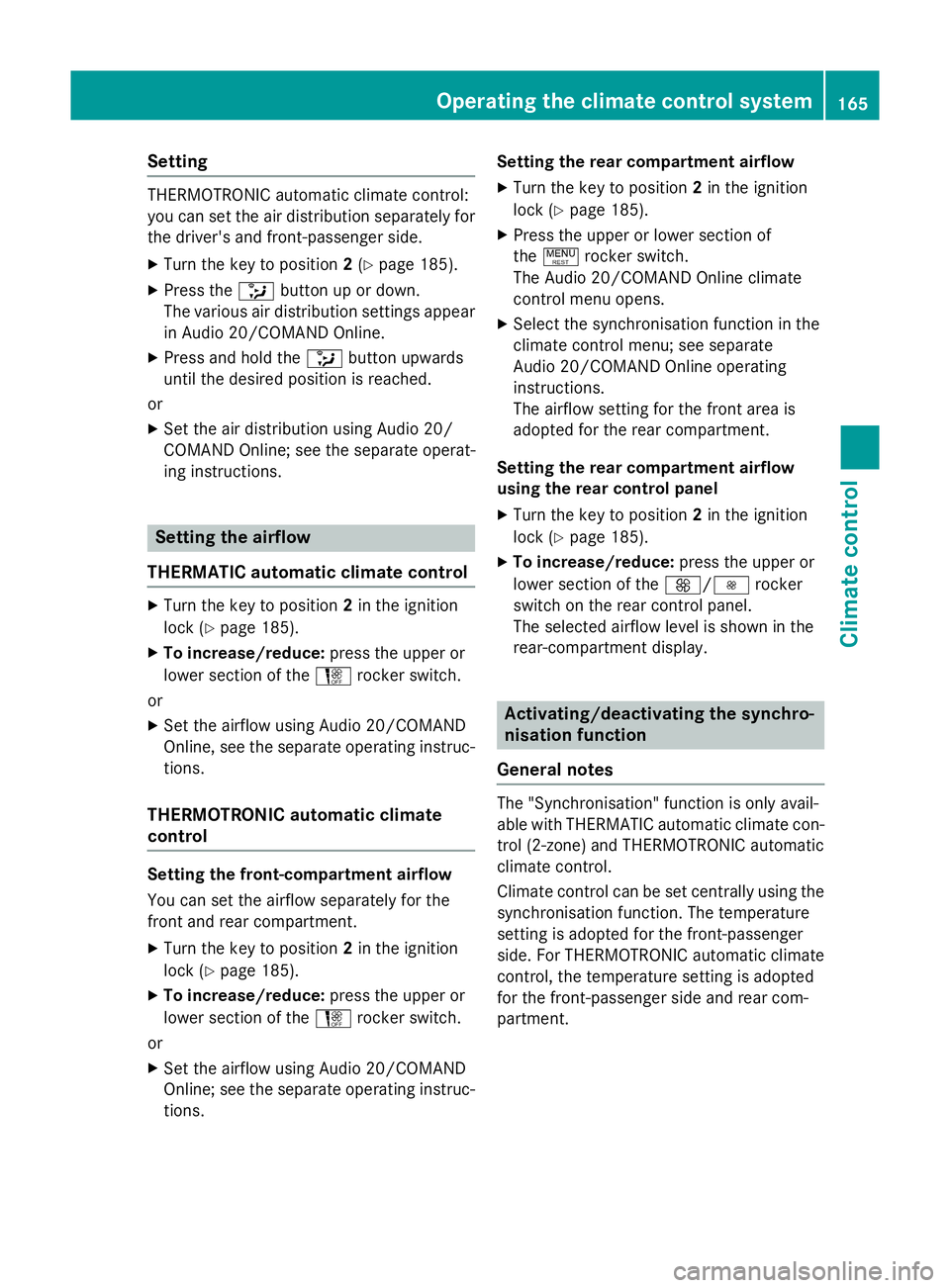
Setting
THERMOTRONIC automatic climate control:
you can set the air distribution separately for
the driver's and front-passenger side.
X Turn the key to position 2(Y page 185).
X Press the _button up or down.
The various air distribution settings appear in Audio 20/COMAND Online.
X Press and hold the _button upwards
until the desired position is reached.
or X Set the air distribution using Audio 20/
COMAND Online; see the separate operat-
ing instructions. Setting the airflow
THERMATIC automatic climate control X
Turn the key to position 2in the ignition
lock (Y page 185).
X To increase/reduce: press the upper or
lower section of the Hrocker switch.
or
X Set the airflow using Audio 20/COMAND
Online, see the separate operating instruc-
tions.
THERMOTRONIC automatic climate
control Setting the front-compartment airflow
You can set the airflow separately for the
front and rear compartment.
X Turn the key to position 2in the ignition
lock (Y page 185).
X To increase/reduce: press the upper or
lower section of the Hrocker switch.
or
X Set the airflow using Audio 20/COMAND
Online; see the separate operating instruc-
tions. Setting the rear compartment airflow
X Turn the key to position 2in the ignition
lock (Y page 185).
X Press the upper or lower section of
the ! rocker switch.
The Audio 20/COMAND Online climate
control menu opens.
X Select the synchronisation function in the
climate control menu; see separate
Audio 20/COMAND Online operating
instructions.
The airflow setting for the front area is
adopted for the rear compartment.
Setting the rear compartment airflow
using the rear control panel
X Turn the key to position 2in the ignition
lock (Y page 185).
X To increase/reduce: press the upper or
lower section of the K/Irocker
switch on the rear control panel.
The selected airflow level is shown in the
rear-compartment display. Activating/deactivating the synchro-
nisation function
General notes The "Synchronisation" function is only avail-
able with THERMATIC automatic climate con-
trol (2-zone) and THERMOTRONIC automatic
climate control.
Climate control can be set centrally using the synchronisation function. The temperature
setting is adopted for the front-passenger
side. For THERMOTRONIC automatic climatecontrol, the temperature setting is adopted
for the front-passenger side and rear com-
partment. Operating the climate control system
165Climate control
Page 181 of 489
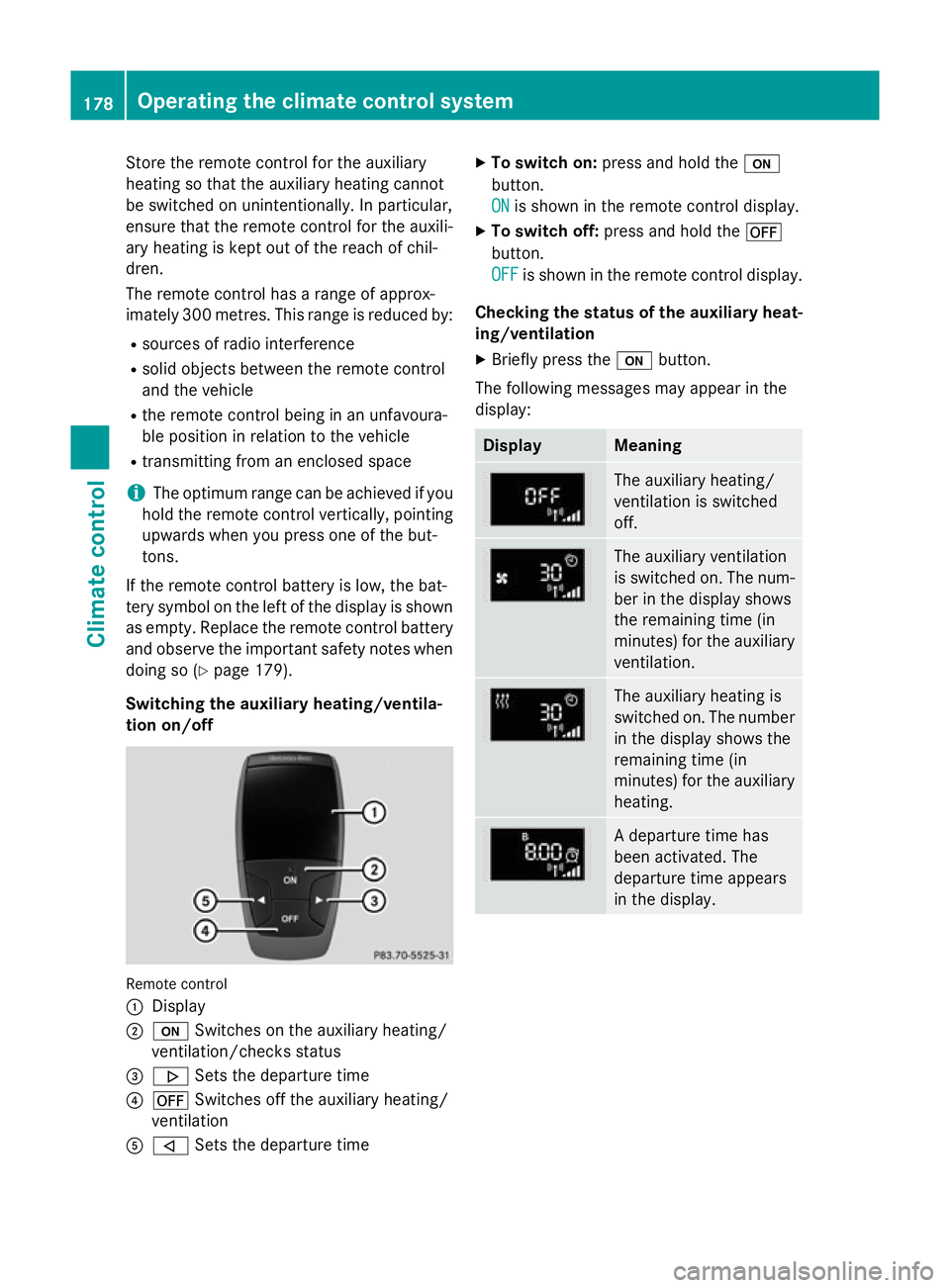
Store the remote control for the auxiliary
heating so that the auxiliary heating cannot
be switched on unintentionally. In particular,
ensure that the remote control for the auxili-
ary heating is kept out of the reach of chil-
dren.
The remote control has a range of approx-
imately 300 metre s. Thisrange is reduced by:
R sources of radio interference
R solid objects between the remote control
and the vehicle
R the remote control being in an unfavoura-
ble position in relation to the vehicle
R transmitting from an enclosed space
i The optimum range can be achieved if you
hold the remote control vertically, pointing
upwards when you press one of the but-
tons.
If the remote control battery is low, the bat-
tery symbol on the left of the display is shown as empty. Replace the remote control battery and observe the important safety notes when
doing so (Y page 179).
Switching the auxiliary heating/ventila-
tion on/off Remote control
:
Display
; u Switches on the auxiliary heating/
ventilation/checks status
= . Sets the departure time
? ^ Switches off the auxiliary heating/
ventilation
A , Sets the departure time X
To switch on: press and hold the u
button.
ON
ON is shown in the remote control display.
X To switch off: press and hold the ^
button.
OFF
OFF is shown in the remote control display.
Checking the status of the auxiliary heat-
ing/ventilation
X Briefly press the ubutton.
The following messages may appear in the
display: Display Meaning
The auxiliary heating/
ventilation is switched
off.
The auxiliary ventilation
is switched on. The num-
ber in the display shows
the remaining time (in
minutes) for the auxiliary
ventilation. The auxiliary heating is
switched on. The number
in the display shows the
remaining time (in
minutes) for the auxiliary heating. A departure time has
been activated. The
departure time appears
in the display.178
Operating the climate control systemClimate control
Page 182 of 489
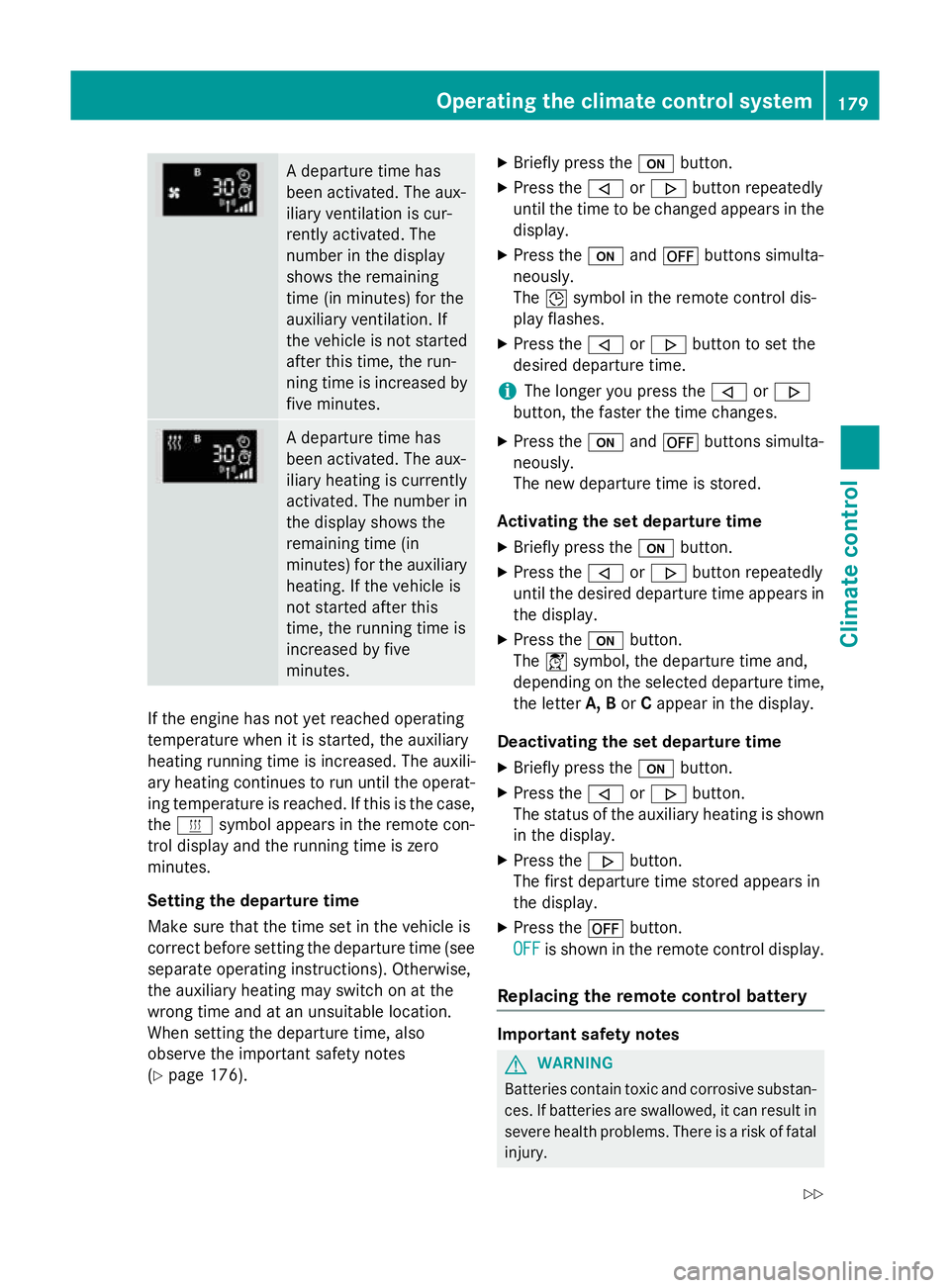
A departure time has
been activated. The aux-
iliary ventilation is cur-
rently activated. The
number in the display
shows the remaining
time (in minutes) for the
auxiliary ventilation. If
the vehicle is not started
after this time, the run-
ning time is increased by
five minutes. A departure time has
been activated. The aux-
iliary heating is currently
activated. The number in
the display shows the
remaining time (in
minutes) for the auxiliary heating. If the vehicle is
not started after this
time, the running time is
increased by five
minutes. If the engine has not yet reached operating
temperature when it is started, the auxiliary
heating running time is increased. The auxili-
ary heating continues to run until the operat- ing temperature is reached. If this is the case,
the y symbol appears in the remote con-
trol display and the running time is zero
minutes.
Setting the departure time
Make sure that the time set in the vehicle is
correct before setting the departure time (see separate operating instructions). Otherwise,
the auxiliary heating may switch on at the
wrong time and at an unsuitable location.
When setting the departure time, also
observe the important safety notes
(Y page 176). X
Briefly press the ubutton.
X Press the ,or. button repeatedly
until the time to be changed appears in the display.
X Press the uand^ buttons simulta-
neously.
The Îsymbol in the remote control dis-
play flashes.
X Press the ,or. button to set the
desired departure time.
i The longer you press the
,or.
button, the faster the time changes.
X Press the uand^ buttons simulta-
neously.
The new departure time is stored.
Activating the set departure time X Briefly press the ubutton.
X Press the ,or. button repeatedly
until the desired departure time appears in the display.
X Press the ubutton.
The Ísymbol, the departure time and,
depending on the selected departure time, the letter A, BorCappear in the display.
Deactivating the set departure time
X Briefly press the ubutton.
X Press the ,or. button.
The status of the auxiliary heating is shown in the display.
X Press the .button.
The first departure time stored appears in
the display.
X Press the ^button.
OFF
OFF is shown in the remote control display.
Replacing the remote control battery Important safety notes
G
WARNING
Batteries contain toxic and corrosive substan- ces. If batteries are swallowed, it can result in
severe health problems. There is a risk of fatal injury. Operating the climate control system
179Climate control
Z
Page 183 of 489
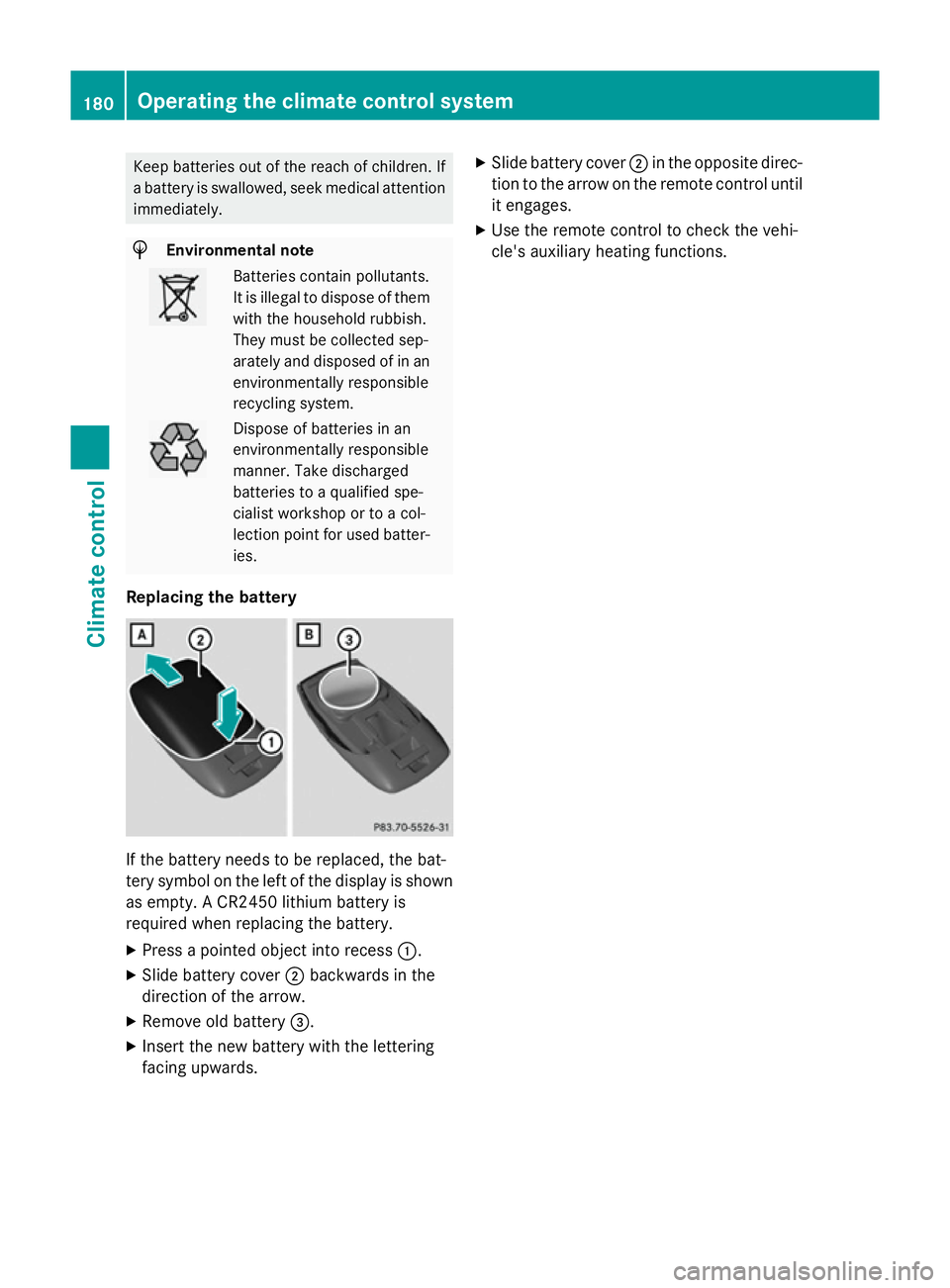
Keep batteries out of the reach of children. If
a battery is swallowed, seek medical attention
immediately. H
Environmental note Batteries contain pollutants.
It is illegal to dispose of them with the household rubbish.
They must be collected sep-
arately and disposed of in anenvironmentally responsible
recycling system. Dispose of batteries in an
environmentally responsible
manner. Take discharged
batteries to a qualified spe-
cialist workshop or to a col-
lection point for used batter-
ies.
Replacing the battery If the battery needs to be replaced, the bat-
tery symbol on the left of the display is shown as empty. A CR2450 lithium battery is
required when replacing the battery.
X Press a pointed object into recess :.
X Slide battery cover ;backwards in the
direction of the arrow.
X Remove old battery =.
X Insert the new battery with the lettering
facing upwards. X
Slide battery cover ;in the opposite direc-
tion to the arrow on the remote control until
it engages.
X Use the remote control to check the vehi-
cle's auxiliary heating functions. 180
Operating the climate control systemClimate control
Page 184 of 489
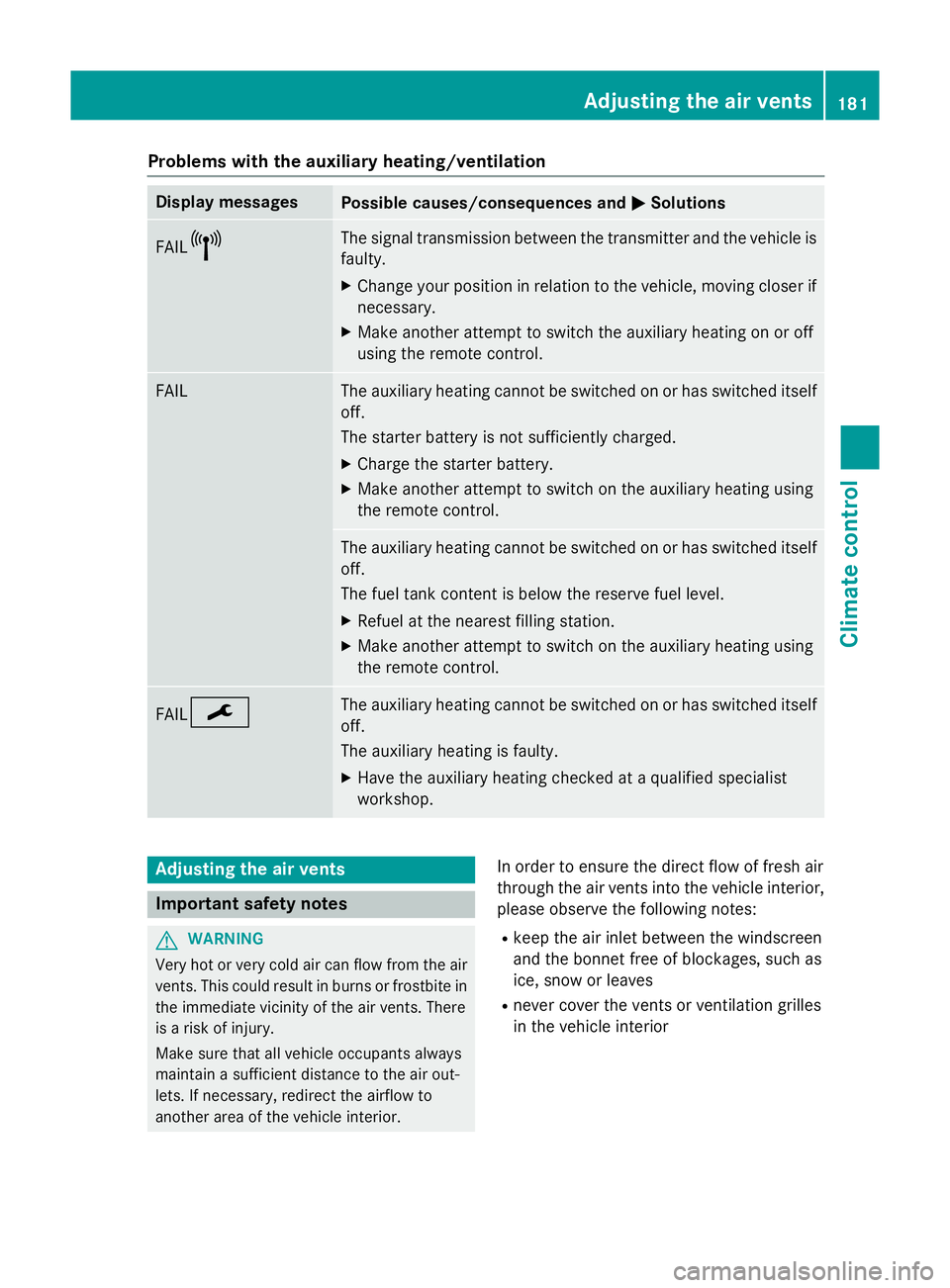
Problems with the auxiliary heating/ventilation
Display messages
Possible causes/consequences and
M
MSolutions FAIL¨ The signal transmission between the transmitter and the vehicle is
faulty.
X Change your position in relation to the vehicle, moving closer if
necessary.
X Make another attempt to switch the auxiliary heating on or off
using the remote control. FAIL The auxiliary heating cannot be switched on or has switched itself
off.
The starter battery is not sufficiently charged.
X Charge the starter battery.
X Make another attempt to switch on the auxiliary heating using
the remote control. The auxiliary heating cannot be switched on or has switched itself
off.
The fuel tank content is below the reserve fuel level.
X Refuel at the nearest filling station.
X Make another attempt to switch on the auxiliary heating using
the remote control. FAIL¯ The auxiliary heating cannot be switched on or has switched itself
off.
The auxiliary heating is faulty.
X Have the auxiliary heating checked at a qualified specialist
workshop. Adjusting the air vents
Important safety notes
G
WARNING
Very hot or very cold air can flow from the air vents. This could result in burns or frostbite in the immediate vicinity of the air vents. There
is a risk of injury.
Make sure that all vehicle occupants always
maintain a sufficient distance to the air out-
lets. If necessary, redirect the airflow to
another area of the vehicle interior. In order to ensure the direct flow of fresh air
through the air vents into the vehicle interior,
please observe the following notes:
R keep the air inlet between the windscreen
and the bonnet free of blockages, such as
ice, snow or leaves
R never cover the vents or ventilation grilles
in the vehicle interior Adjusting the air vents
181Climate control Z